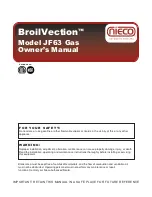
Page 4
LAARS Heating Systems
1.8 Jacket (normally fitted)
If not fitted, assemble panels in accordance with
in struc tions in Figure 4.
1.9 Oil Burner (normally fitted)
If not fitted, insert burner tube into boiler so
that it is ap prox i mate ly ¼" (6mm) from inside wall of
ceraform chamber, then clamp mounting flange and
bolt up to front-plate (see Figure 3).
The burner should be wired and connected to
the oil line in accordance with the manufacturer’s
instructions.
1.10 Installation of Alternate Nozzles for
Higher Output
This operation shall only be carried out by a
trained and licensed Service Technician in accordance
with the burner manufacturer’s instructions included in
the literature package provided with this boiler.
1.11 Boiler Controls (normally fitted)
If controls are supplied separately, fit them to the
boiler in the positions shown in Figure 3, with jacket
in place.
Circulator - 1¼" return tapping at front of boiler.
Tridicator - temp/press. gauge.
Relief Valve - Provide ¾" tee and auto vent as
shown on front page for air elimination.
Aquastat Relay - L8124A or L7224A - ¾"
tapping in coil plate.
Fit a drain valve (not supplied) in a tee at
hy dron ic return connection and check all connections
are made wa ter tight.
1.12 Oil
USE ONLY No. 2 HEATING OIL. Do not use
gasoline, crankcase draining or any oil con tain ing
gasoline.
1.13 Oil Storage and Pipe Layout
Storage Tank:
Consult local fire and building
codes for acceptable fuel storage methods in your area.
Fuel Line:
A single pipe system of not less
than 3/8" OD copper tubing is recommended when
fuel storage level is not below the fuel unit. A two
pipe system of not less than 3/8" OD copper tubing is
recommended when lowest fuel level is below but not
more than 8 feet below fuel unit.
Important:
Refer to burner (pump) instructions
for detailed fuel line and pump usage information. All
installations must conform to local and national codes.
See Figures 5A and 5B.
Figure 5A One-pipe system - pipe and tank
layout.
Figure 5B Two-pipe system - pipe and tank
layout.
1.14 Electrical Wiring
All wiring must comply with the National
Electrical Code, NFPA 70, local codes and ordinances
regarding wire size, type of insulation and enclosures
etc. (see Figure 6).
1.15 Operation (Honeywell L8124A or
L7224A aquastat relay)
A call for heat from the room thermostat causes
the re lay to “make “ the burner circuit and also feed
the cir cu la tor provided the boiler water tem per a ture is
above the low limit setting (usually 190°F [88°C] to
210°F [99°C]). The burner and cir cu la tor then continue
to run until the room thermostat is satisfied.
A high limit switch shuts off burner in the event
of water temperature exceeding the high limit setting,
usually 20°F (-7°C) to 30°F (-1°C) above the low limit
setting.
The low limit switch and circulator maintain
boiler water temperature for domestic hot water
ser vic es and pre vent circulation of heating system
water if domestic water is not hot enough.
1.16 Domestic Water Piping
1. Connect anti scald tempering valve (12) “HOT”
port to hot water outlet from unit. This valve
should be mounted 3" (76mm) to 6" (152mm)
below the outlet and set for 120° F mixed
delivery temperature or as local codes dictate
(see Figure 1).
2. Connect gate or shutoff valve (13) to anti scald
tempering valve (12) “MIX” port, and another to
the cold water inlet.
3. Connect pressure relief valve (11) (if required
by codes), maximum 150 PSI as close to the unit
as possible. No other valves or restrictions may
be installed between the DHW coil and the
relief valve.
(DO NOT USE A TEM PER A TURE/PRES SURE
RELIEF VALVE AS THIS IS NOT A STOR AGE
HOT WATER HEATER).
B
O
I
L
E
R
11
12
13
3 - 6"
(76mm - 152mm)
Figure 1. Domestic water piping.
OUT OF
PRODUCTION






























